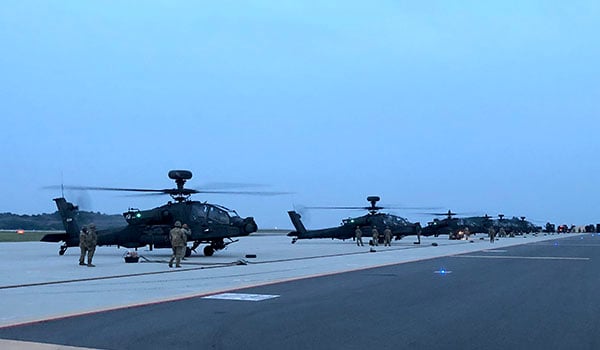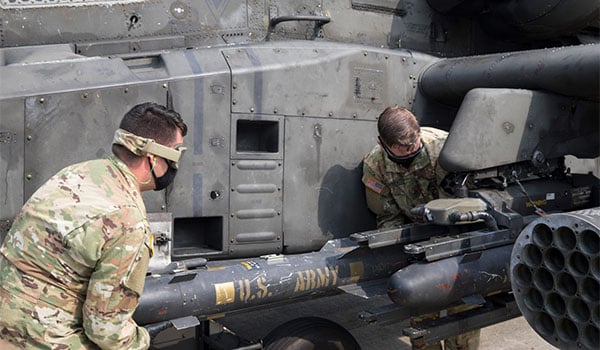
By CPT Edmund Lee and CPT Ryan Riemer: ATP 3-04.1 Aviation Tactical Employment notes that forward arming and refueling points (FARPs) often become a limiting factor when conducting sustained attack aviation operations. In attack battalions (AB) and air cavalry squadrons (ACS), aviation planners often lack a thorough understanding of sustainment operations and their organic Forward Support Company/Troop (FSC/T) capabilities. The reverse holds true for logisticians in the FSC/T and S-4 shop, who may not understand some of the unique requirements of aviation FARPs compared to the Refuel On the Move techniques utilized by brigade combat teams. This article provides some basic techniques and lessons learned from 4-2 Attack Battalion’s experience simulating Large Scale Combat Operations (LSCO) in the Korean theater to supplement the broad planning considerations in ATP 3-04.17, Techniques for Forward Arming and Refueling Points.
 From 2018 to 2020, 4-2 Attack Battalion (Death Dealers), 2nd Combat Aviation Brigade conducted several battalion-level training events, eventually culminating in all three companies conducting a simulated phased attack out of contact with friendly forces approximately 210 kilometers from the tactical assembly area (TAA). To extend operational reach and maximize aircraft time on station, the organic FSC emplaced an eight-point jump FARP (JFARP) consisting of two four-point HEMTT Tanker Aviation Refueling Systems (HTARS) approximately 120 kilometers from the TAA.
From 2018 to 2020, 4-2 Attack Battalion (Death Dealers), 2nd Combat Aviation Brigade conducted several battalion-level training events, eventually culminating in all three companies conducting a simulated phased attack out of contact with friendly forces approximately 210 kilometers from the tactical assembly area (TAA). To extend operational reach and maximize aircraft time on station, the organic FSC emplaced an eight-point jump FARP (JFARP) consisting of two four-point HEMTT Tanker Aviation Refueling Systems (HTARS) approximately 120 kilometers from the TAA.
Surge Ops Support
During “surge” operations such as phased or maximum destruction attacks, logistics planners should aim to emplace the maximum amount of FARP pads at the TAA or JFARP to maximize throughput and minimize aircraft idle time. The current Military Table of Organization and Equipment (MTOE) authorizes an FSC/T three HTARS and two Advanced Aviation Forward Area Refueling Systems (AAFARS). Assuming all equipment is on-hand and operational, the three HTARS can support four points each for a total of twelve points, while the AAFARS can theoretically also support four points each for an additional eight points. Based on real-world experience, the HTARS and M978 HEMTT supply sufficient pressure to simultaneously refuel up to four points, with an increase of approximately three to five minutes refueling time compared to refueling three pads simultaneously. The AAFARS can be sling-loaded or carried internally by a CH-47 Chinook to provide JFARP capability. However, the AAFARS provides minimal pressure when refueling more than one point at a time, making it a secondary option when speed and throughput are primary considerations. 4-2 AB employed two M978 HEMTT fuel tankers per four-point HTARS, utilizing the Y-hose fitting (NSN: 4730-01-515-3578) from the AAFARS. This configuration provided approximately 4,800 gallons of JP8 per four-point HTARS, and the ability to rapidly switch distribution trucks should a pump fail.
 A potential surge mission could consist of two four-point HTARS for an eight-point JFARP to maximize aircraft throughput, with the two AAFARS in reserve or utilized for a second JFARP or silent FARP. The third four-point HTARS would support the TAA FARP, with remaining M978 HEMTT tankers capable of conducting cold or warm refuel directly to aircraft. This configuration requires substantial physical space and assumes the FSC/T has most of its equipment fully mission capable. It also assumes the FSC/T is operating without augmentation from the Aviation Support Battalion (ASB) or other external enablers. It is critically essential that the FSC/T commander and S4 are incorporated into the Military Decision Making Process (MDMP) early so they can understand mission requirements, generate options for the commander, and request augmented support, as necessary.
A potential surge mission could consist of two four-point HTARS for an eight-point JFARP to maximize aircraft throughput, with the two AAFARS in reserve or utilized for a second JFARP or silent FARP. The third four-point HTARS would support the TAA FARP, with remaining M978 HEMTT tankers capable of conducting cold or warm refuel directly to aircraft. This configuration requires substantial physical space and assumes the FSC/T has most of its equipment fully mission capable. It also assumes the FSC/T is operating without augmentation from the Aviation Support Battalion (ASB) or other external enablers. It is critically essential that the FSC/T commander and S4 are incorporated into the Military Decision Making Process (MDMP) early so they can understand mission requirements, generate options for the commander, and request augmented support, as necessary.
Considering Rearm Time
Attack aviation FARPs are uniquely different from lift aviation FARPs in that AH-64s require extended time for rearming. It is not unusual for aircraft to spend anywhere from ten to thirty additional minutes on a pad rearming after they have completed refueling. Techniques to minimize this downtime include cross-training personnel and optimal task organization at the FARPs. In 4-2 AB’s FSC distribution platoon, all of the 88Ms (Motor Transport Operators), 89Bs (Ammunition Specialists), and 92Fs (Petroleum Supply Specialists) were cross-trained to conduct refueling operations, as well as assist 15Ys (AH-64 Armament/Electrical/Aviation Systems Repairers) with loading rockets and missiles. Using the previous surge scenario, the distribution platoon has enough personnel (approximately fifty by MTOE) to simultaneously man all of the FARP pads with two to four Solders each, with personnel leftover for post-surge operations. This cross-training frees up the usually limited numbers of 15Ys to conduct the more technical task of reloading 30mm rounds, as well as troubleshooting aircraft issues or supervising rocket and missile rearming.
An Aviation maintenance company/troop (AMC/T) typically has thirty to forty 15Ys, with their tasks split between scheduled/unscheduled maintenance, troubleshooting aircraft issues during launch and recovery, and supporting FARP operations. One viable method of task organization is to attach a sub-section of 15Ys to each four-point FARP, subordinate to the FARP officer or noncommissioned officer in charge. A sergeant or above would lead each sub-section, with subordinate teams of at least two 15Ys per FARP point. The two team members would focus on 30mm reloading, allowing the sub-section leader to supervise rocket and missile rearming or troubleshoot aircraft issues. Using the surge scenario of eight JFARP points and four TAA points, this would incur a requirement of approximately twenty-seven 15Ys, which seems high but is attainable for a momentary surge period. As necessary, Soldiers from the other companies/troops can easily further augment rocket/missile rearming teams during a surge operation. The Army may need to increase the amount of 15Ys in the AMC/T MTOE to account for the expected increase of unscheduled maintenance, battle damage repair, and aircraft recovery tasks in a LSCO environment.
Summary
FARPs are critical to achieving offensive concentration and sustaining tempo in attack aviation operations. This article has provided a few methods for supporting a maximum destruction or phased attack operation, using only organic AB/ACS equipment and personnel. Key to these techniques is understanding and maximizing use of on-hand equipment, cross-training Soldiers to conduct multiple tasks, and effective leadership in the right locations. Ultimately, it is essential that aviation and logistics planners work together throughout all stages of MDMP to appropriately assess mission requirements, generate viable and sustainable courses of action, and request external support, as necessary.
CPT Edmund Lee is an aviation officer at Fort Rucker, AL, and CPT Ryan Riemer is the 8th U.S. Army G-4 POL & Water Branch Chief at U.S. Army Garrison Humphreys, Korea. Both were previously assigned to 4th Battalion (Attack), 2nd Combat Aviation Brigade.
An attack company refuels at a JFARP to enable extended reach for an attack out of contact with friendly forces. / ARMY PHOTO BY CPT RYAN RIEMER
4-2 AB Soldiers conduct cross-training to increase efficiency and proficiency of rearming operations./ ARMY PHOTO BY CPT RYAN RIEMER







